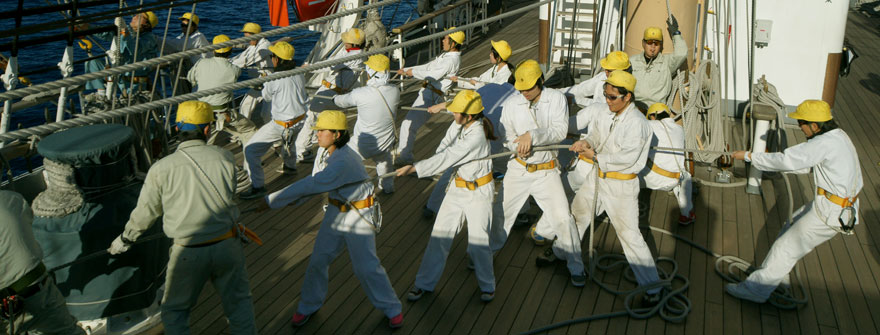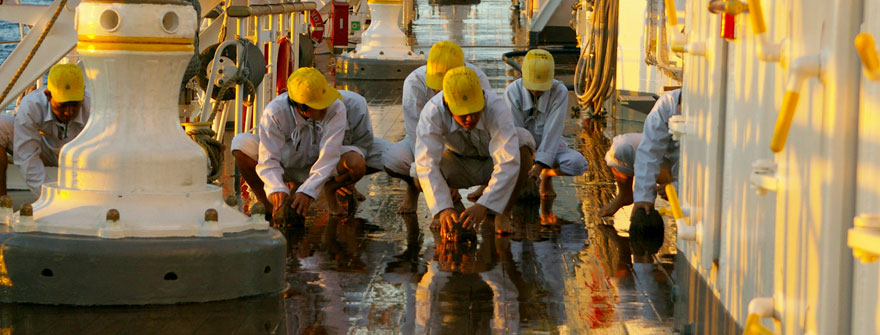Contributions from Experts
Some Thoughts on Training Using Sailing Ships
On the midsummer afternoon of Saturday, July 26, 2014, the training ship Kaiwo Maru was berthed at the wharf in Maizuru Port. Although the temperature exceeded 35 °C, and the midsummer sun shone unrelentingly, fortunately, the humidity was low, and a brisk sea breeze could be felt from time to time. Many visitors, including grandparents and grandchildren, young couples, elementary and middle school children, and fans of sailing ships swarmed the wharf, waiting for the start of the Sail Drills.
Approximately 100 young cadets dressed in training wear and yellow caps appeared on deck. Following the command to commence the drill, they began by setting the yard (a horizontal boom for setting the sail), taking into account the direction of the wind. Amid the piercing sounds of the instructor’s sharp whistle and the cries of cadets to “Seno-Washoi!(“Heave-ho!”),” the yard slowly turned and eventually stopped.
Next came the operations to set the sail. The voice of the Captain giving the overall commands blared from a loudspeaker, “Due to strong winds today, there is a chance of a runaway if all the sails are set. The temperature is also high and there is a danger of heat exhaustion if we continue operations for a long time. Therefore, we will not set the sails for the top two yards.”
The top of the mast towers 50 meters above the water surface. Even limiting the setting of the sails to the fourth yard from the bottom, the height of that yard easily exceeded 30 meters.
Aiming for a height equivalent to about a 10-story building, the cadets slowly climbed up the rope ladder to the mast without stopping, looking quite audacious and impressive. Once they reached the height of the yard, they immediately moved in a horizontal direction and undid the sail ties to let the sail unfurl. Those on deck then pulled on a rope that passed through the lower end of the sail, tightening it, and allowing it to billow as it filled with wind. The entire operation took about an hour. While we wanted visitors to enjoy this majestic sight of the Kaiwo Maru as long as possible, our schedule was tight. After a short time, the trainees started to put everything back to its original position, stowing the sails in reverse order. After completing their duties, they formed a line on deck, and received a robust round of applause from the audience on the wharf.
Even today many large sailing ships are still in service around the world as can be seen in the calendar series “Sailing Ships of the World” published by the Japan Maritime Public Relations Center. These ships actively take part in goodwill call to various countries and in various maritime events. However, it can be said that Japan is the only country that fully utilizes its sailing ships for onboard training(*1). When I used to work for the Maritime Academy Foundation, I was often asked questions like “I understand the attraction of sailing ships very well. Today, however, when the era of tall ships has long passed, why do you need the onboard training by sailing ships?” (See note (*2) regarding the relationship between the Foundation and the Kaiwo Maru).
Although this question really reflects the current status, I always answered these kinds of questions in the following way:
“We have two objectives in our use of sailing ships for training. The first is for our trainees to learn teamwork through onboard training. Both the Nippon Maru and Kaiwo Maru have 36 sails respectively, and setting and stowing the sails and moving the yards are all done by cadets themselves. This requires everyone to unite as one, call out to each other, and synchronize timing. If any of these elements is missing, the trainees’ mission cannot be accomplished. I cannot think of a more suitable environment than this for learning the importance of teamwork firsthand. Countries such as Russia and Poland also utilize sailing ships. However, these ships are used only for familiarization training in the initial stage of onboard training. “The second reason is to convey to trainees a sense of the power of the wind and the power of waves caused by the wind. This experience instills in them a sense of awe regarding the power of nature. We never know what kind of adverse weather we may encounter at sea. No matter how much information can provide us by IT, it is ultimately humans who must decide whether to continue a voyage or turn back. Therefore, it is essential for us to have a sense of awe regarding the power of nature. In this context, practical training aboard sailing ships plays a vital role even today.”
Unlike training overseas, in Japan it is customary to use sailing ships not only in the initial stage but also in the middle and/or final stages of the 12 months of onboard training. Having onboard training on sailing ships after acquiring fundamental knowledge of ships enables cadets to acquire an adequate understanding of the impact of natural phenomena on ships.
With the wide use of simulators for training purposes today, interest in the training of seafarers seems to be moving in the direction of how to provide training to students who cannot obtain onboard training. In countries that either do not have training ships or cannot provide training entirely on training ships for 12 months, there is no choice but to place students on merchant ships. Therefore, I believe the need for training ships that can provide onboard training to a large number of students will further increase in the future worldwide.
Sailing ships certainly have a romantic image. However, the value of using sailing ships for training goes far beyond its romantic aspect. Moreover, the experience they offer cannot be substituted by simulators. To borrow the words of the Duke of Wellington(*3), we can perhaps say, “The battle of the Japanese merchant marine will be won on the decks of the Nippon Maru and Kaiwo Maru.” I sincerely hope that both ships will continue to provide this valuable experience to trainees in the future.
(*1) While there are examples of countries like Russia and Poland incorporating practical training on sailing ships in their training programs, their use of such ships is limited to familiarization training in the early stages, and sailing ships are not used for the same objectives as in Japan, other than for the initial familiarization training. (This does not apply to the coast guards and navies of those countries.)
(*2) Both the original Nippon Maru and Kaiwo Maru ships were built in the early Showa Period (1926 – 1989), and were decommissioned after serving as training sailing ships for a little over 50 years. While construction of the ship that replaced the original Nippon Maru was fully funded by the government, the ship that replaced the original Kaiwo Maru, due to fiscal reasons, was built with public donations, a grant from the Japan Shipbuilding Industry Foundation, a governmental subsidy, and bank loans. The fundraising was undertaken by the “Renshusen Kyoiku Koenkai,” an association for supporting training ship education, and the association leased the ship after its completion to the then-named National Institute for Sea Training. The Maritime Academy Foundation took over this work and remains in charge at present.
(*3) The Duke of Wellington (1769-1852). British soldier and statesman who defeated Napoleon at the battle of Waterloo in 1815. Of the victory, he is said to have remarked, “The battle of Waterloo was won on the playing fields of Eton.” Here he was alluding to the difference in basic training of officers in Britain and France, which was the determining factor in who became the victor and loser in that battle.
Mr. Mitsushi Kojima
Auditor
Marine Rescue Japan

